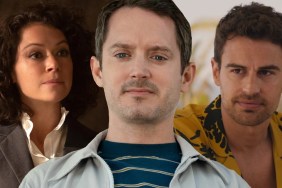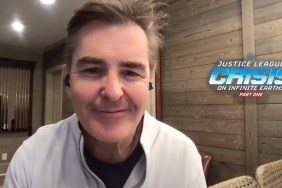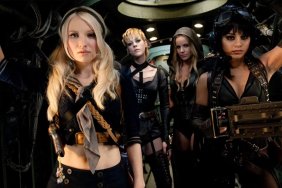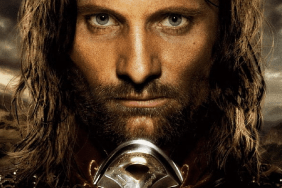Cast:
Martin Freeman as Bilbo
Ian McKellen as Gandalf
Richard Armitage as Thorin
Ken Stott as Balin
Graham McTavish as Dwalin
William Kircher as Bifur / Tom Troll
James Nesbitt as Bofur
Stephen Hunter as Bombur
Dean O’Gorman as Fili
Aidan Turner as Kili
John Callen as Oin
Peter Hambleton as Gloin / William Troll
Jed Brophy as Nori
Mark Hadlow as Dori / Bert Troll
Adam Brown as Ori
Ian Holm as Old Bilbo
Elijah Wood as Frodo
Hugo Weaving as Elrond
Cate Blanchett as Galadriel
Christopher Lee as Saruman
Andy Serkis as Gollum
Sylvester McCoy as Radagast
Barry Humphries as Great Goblin
Jeffrey Thomas as Thror
Michael Mizrahi as Thrain
Lee Pace as Thranduil
Manu Bennett as Azog
Conan Stevens as Bolg
John Rawls as Yazneg
Stephen Ure as Fimbul / Grinnah
Timothy Bartlett as Master Worrywort
Bret McKenzie as Lindir
Benedict Cumberbatch as Necromancer
Directed by Peter Jackson
Summary:
“The Hobbit: An Unexpected Journey” is a fun return to Middle-earth and a faithful adaptation of the book, with a few extras thrown in. Great 3D and amazing action and effects make it a must-see, but seeing the film in 48 fps is a bit of a mixed bag, so you may want to try it out in both formats.
Story:
“The Hobbit: An Unexpected Journey” is based on the novel by J.R.R. Tolkien written in 1937.
Sixty years before the events in “The Lord of the Rings,” Bilbo Baggins is a simple hobbit living a simple life in the Shire. Enjoying his pipe, his food, and his home, things are peaceful and quiet for him. That is until Gandalf the Grey arrives, quickly followed by thirteen dwarves.
The dwarves, led by Thorin Oakenshield, are on a quest to retake their home of Erebor from the evil dragon Smaug who claimed it for his own many years before. The dwarves have since been a wandering people without a home, but now they’re determined to take it back. With the help of the wizard Gandalf, they intend to do just that.
Bilbo is reluctantly recruited for the quest as a ‘burglar’ since hobbits are known for their ability to sneak around unnoticed. Little does Bilbo know that his journey will lead him into conflict with trolls, orcs, goblins, waargs, stone giants, and the wretched creature Gollum.
“The Hobbit: An Unexpected Journey” is rated PG-13 for extended sequences of intense fantasy action violence, and frightening images.
What Worked:
It’s a great treat to be able to revisit Middle-earth again! I don’t think I realized how much I missed it until the opening scenes of this film rolled. The familiar faces of Bilbo, Gandalf, Saruman, Elrond, Galadriel, Frodo, and especially Gollum are great to see again along with many new characters. While one might initially question a return to this world and the need to split a single book into three films, it doesn’t take long to realize how rich and deep Middle-earth is and that there are a lot more corners to explore within it. As soon as the camera zooms within the halls of Erebor, you are hit with the realization that there is much, much more to see and you want to take as much time exploring it as possible.
I read “The Hobbit” and the “The Lord of the Rings” books many years ago. “The Hobbit” was always my favorite because the story was more straightforward, it was more simply written, it had more humor in it, and there was more of the adventure feel that I always love. While it helped make a better novel, I think that lighter tone is going to make or break the film for a lot of moviegoers unfamiliar with the book. There are several times where the characters sing. There’s a scene where the dwarves are doing dishes that’s very comedic. The trolls are very comical and very much unlike the animalistic ones seen in “The Lord of the Rings.” There are light or funny moments sprinkled all through the movie. While I enjoyed the tone, I think those not expecting it might take issue with it. Familiarity with the source material is a factor in enjoyment here, I believe.
While there is humor in “The Hobbit: An Unexpected Journey,” there is plenty of action, horror, and suspense, too. We are treated to an epic battle between the dwarves and the orcs. A cool fight between Thorin and the pale orc Azog is quite impressive and finally delivers on the dwarves’ reputation as warriors. Then there’s the spectacular battle between the stone giants that will make any kaiju fan drool. The action peaks with a massive battle between the goblins and our heroes. The sheer complexity of the camerawork, the fight choreography, the production design, and the CGI will take many, many viewings to fully absorb. If you loved “The Lord of the Rings” for the action and effects, there’s plenty here to keep you happy.
Peter Jackson works great with ensemble casts and he does so here again. He gives all of the dwarves moments to shine. Richard Armitage gets most of the spotlight as Thorin, but it is well deserved. He does a good job playing the king who wears the crown heavily, but it’s still believable that he’d be running around with some of the more cartoony characters in this band. Martin Freeman is also fantastic as Bilbo. We briefly see Ian Holm as Old Bilbo in the opening scene, but there’s no problem whatsoever accepting Freeman as the younger version of the character. He’s just as frazzled, overwhelmed and awestruck as he is in the books. But while the new cast members do excellent jobs, Tolkien veterans Ian McKellen and Andy Serkis still manage to be the MVP’s of this film. As Gandalf the Grey, McKellen gets to bring a lot more humor and life to the wizard than he was able to in “The Lord of the Rings.” It’s fun to see him interact with feasting dwarves, get dressed down by Galadriel and Saruman, and climb up a tree to save his life. He’s more human and vulnerable here, and that makes him a more fun character. But my favorite remains Andy Serkis as Gollum. He’s not in the movie very long, but he steals the show with what little time he has. Seeing him in a battle of wits with Bilbo is very entertaining (though I must admit that I had some trouble understanding some of the dialogue). I could watch an entire movie with nothing but Gollum.
This is the first Tolkien movie in 3D and I found it was used very effectively. As Bilbo blows smoke from his pipe, it swirls around out of the screen. In scenes with rain, it feels like it’s raining in the theater as the drops have real depth. And as the camera sweeps through the dwarf mines or the goblin kingdom, you get a real appreciation for the depth and detail of the CGI. Overall, I loved the 3D in this movie and it makes me wonder what a converted “The Lord of the Rings” would look like in 3D, too.
Howard Shore delivers yet another strong score with “The Hobbit: An Unexpected Journey.” Familiar themes from “The Lord of the Rings” are sprinkled throughout it, but his main theme (which I think is titled “Misty Mountains”) is one of the more memorable themes of any movie this year. If you heard it played, you’d immediately know it was from “The Hobbit” unlike the unrecognizable music from many movies this year. “Song of the Lonely Mountain” takes that theme and expands it into a full song by Neil Finn. The end result is one of the better movie songs of the year.
My kids were young enough that they missed seeing “The Lord of the Rings” in theaters. They’ve only seen it on Blu-ray and in the LEGO video games. So it’s quite a treat to be able to take them to the theater and have them experience a Tolkien movie on the big screen for the first time. For them, it’s an epic theatrical experience like “Star Wars” was for me in the ’70s and ’80’s. They loved this Hobbit film and so did I.
What Didn’t Work:
OK, let’s talk about this 48 frames per second thing. I’ll start out by saying that I’m not one of these picture nitpickers. If the movie is in focus and the picture is bright, I’m generally quite happy. And I didn’t go into “The Hobbit” with any preconceived notions. If Peter Jackson was excited about it, then I wanted to see what he was excited about. I went into this with an open mind. Now having seen it for myself, I will say that I feel it’s a mixed bag. There are parts of it where the higher frame rate really helps the film. In scenes where the dwarves and orcs are fighting or where the goblins are swarming, the high frame rate gives it all a very real feeling and makes it look less like CG and more like real life. It’s amazing. Quiet scenes where the camera is relatively still and characters are talking are also impressive. You feel like you’re sitting in a room with them listening to them have a conversation. Scenes where the dwarves are walking in broad daylight along mountain peaks also look like documentary footage and again are helped by the higher frame rate. Where everything falls apart is any scene where a character is moving fast on the screen. In the opening moments of the film, Bilbo is seen walking down a hall and opening a chest. For some strange reason it looks like he’s moving in fast forward. He looks like Benny Hill moving quickly across the screen and it immediately rips you out of the moment. You think, “Oh, no. What have I gotten myself into.” This fast forward effect happens with some of the other dwarves, too. Then scenes where there’s a lot of action and the camera goes into shaky cam’ mode really messes with your eyes. And since there’s no motion blur, some of the action scenes look like they’ve come straight from a video game. It’s weird and hard to describe. And while it helps the CGI in some parts, it hurts it in others, particularly in scenes with Radagast being pulled by a rabbit sled. It looks particularly CG and it’s not just because it’s a sled pulled by rabbits. There are other moments where the high frame rate makes the picture look like soap opera quality. It feels more real’ and less otherworldly. It’s just really strange how it alternately works and does not work. Some people mentioned motion sickness or headaches when viewing it at 48 fps, but I didn’t experience either. One of my children said he had a headache afterwards while the other one didn’t. I don’t think the one that said he had a headache really did I think he was just parroting what he heard on the news. So is it worth seeing in 48 fps? I’d say yes, if nothing more than to judge it for yourself. I’ve seen it in 48 fps and I plan to go back and see it again in 24 fps for comparison. But I think if directors like James Cameron and Bryan Singer are going to want to shoot in this format, then they need to change the way that they shoot to make the most of it. Otherwise their films are going to be a visual mess. Filming technique needs to be tailored to frame rate and I think they’re still in the experimental stage. Most people are going to find it to be a rather unwelcome distraction from an otherwise great movie.
As for the story itself, there were some minor issues. While I absolutely loved seeing Frodo and Galadriel and Elrond in the film, I have to reluctantly admit that they felt shoehorned into the plot. A lot of time is spent connecting this film to the events in “The Lord of the Rings” and it doesn’t quite feel like it naturally fits into the overall story. We see the earliest hints of the return of Sauron and it feels like a digression from the main dwarf quest. That’s certainly the case when the movie is 2 hours and 45 minutes long, and especially the case with the wizard Radagast who could have been eliminated entirely and been barely missed.
I’ve also heard the criticism that the basic plot structure of “The Hobbit: An Unexpected Journey” is too close to “The Lord of the Rings: The Fellowship of the Ring.” People familiar with the books deflect the criticism by saying, “You idiot, it’s faithful to the novel.” But, honestly, they are very familiar in structure. Frodo and Bilbo are both recruited in similar scenes. They both join ragtag bands. There are similar scenes of them walking across beautiful New Zealand mountains. They both end up in Rivendell. They both trek through the mountains and end up in a mine infested with orcs or goblins. Beat for beat they are almost identical. Only the details are changed. While it is of no concern to anyone familiar with the books, people that only know the movies may have a legitimate complaint here. But how you address this without significantly deviating from the novel, I don’t know. It is what it is.
The Bottom Line:
Overall, “The Hobbit: An Unexpected Journey” was an enjoyable experience for me and my family. If you can get past the 48 fps issue, I think you’ll find it a pleasant return to Middle-earth. The Christmas of 2013 can’t come soon enough!










